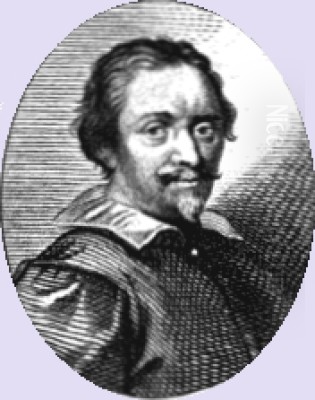
Philipp Peter Roos, often known by his evocative nickname "Rosa da Tivoli," stands as a significant figure in the landscape of German Baroque art. Active primarily during the latter half of the 17th and the very beginning of the 18th century, Roos carved a distinct niche for himself as a masterful painter of animals and pastoral scenes, spending the most productive and defining years of his career not in his native Germany, but under the warm, inspiring skies of Italy. His work bridges the Northern European tradition of detailed observation with the dramatic flair and compositional dynamism of the Italian Baroque, creating a unique artistic identity that resonated with collectors of his time and continues to be appreciated in major museum collections across Europe. This exploration delves into the life, artistic development, style, and legacy of this intriguing painter.
Early Life and Artistic Foundations in Germany
Philipp Peter Roos was born into an artistic family in Frankfurt am Main around 1657. Artistry was deeply ingrained in his lineage; his father was the respected landscape and animal painter Johann Heinrich Roos (1631–1685), who provided Philipp Peter with his foundational training. The elder Roos was himself a notable artist, known for his idyllic landscapes populated with livestock, often bathed in a warm, golden light reminiscent of the Dutch Italianate painters. This familial environment undoubtedly shaped the young Roos's artistic inclinations from an early age, steering him towards the genres that would define his career.
His brother, Johann Melchior Roos (1663–1731), also followed the family path, becoming a painter known for similar subject matter, though perhaps without achieving the same level of international renown as Philipp Peter. Growing up surrounded by the tools, techniques, and discussions of painting, particularly focused on landscape and animal depiction, provided Philipp Peter with a solid technical grounding and a clear thematic direction. His early works, though less documented, likely reflected the style of his father, emphasizing careful observation of animal anatomy and pastoral settings common in German art of the period.
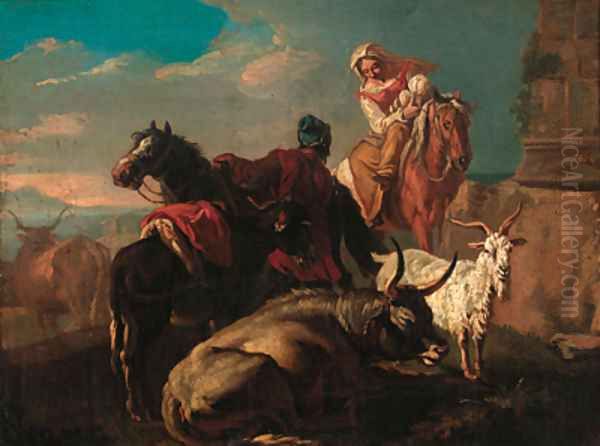
The artistic milieu of Frankfurt, while perhaps not as central as cities like Rome or Amsterdam, offered opportunities for learning and exposure. However, for an ambitious young artist, particularly one drawn to the classical landscapes and vibrant artistic energy that emanated from the south, the lure of Italy was powerful. This pull, combined with a crucial opportunity for patronage, would soon set the course for the rest of his life and artistic journey.
The Transformative Journey to Rome
A pivotal moment arrived in 1677 when Philipp Peter Roos secured a prestigious scholarship from Landgrave Karl of Hesse-Kassel. This financial support enabled him to undertake the journey that was becoming almost a rite of passage for ambitious Northern European artists: travel to Italy, specifically to Rome, the epicenter of the art world at the time. Rome offered unparalleled opportunities to study classical antiquity, the masterpieces of the High Renaissance, and the dynamic works of contemporary Baroque masters.
Upon arriving in Rome, Roos quickly immersed himself in the city's vibrant, international artistic community. He sought further instruction to refine his skills and broaden his horizons beyond his initial training. This led him to the studio of Giacinto Brandi (1621–1691), a prominent Roman painter known primarily for his large-scale historical and religious works in a vigorous High Baroque style. While Brandi's focus on history painting differed from Roos's burgeoning specialization in landscape and animals, the apprenticeship likely exposed Roos to the principles of Baroque composition, dramatic lighting, and the energetic brushwork prevalent in Rome.
Roos's integration into the Roman art scene was further solidified by his involvement with the Schildersbent, more famously known as the "Bentvueghels" (Dutch for "birds of a feather"). This was a confraternity, largely composed of Dutch and Flemish artists working in Rome, known for its bohemian character and initiation rituals. Joining this group provided camaraderie, professional connections, and a platform within the Northern artist community in the city. It was within the Bentvueghels that Roos reportedly received his first nickname, "Mercurius" (Mercury), allegedly bestowed upon him due to the remarkable speed and facility with which he could paint. This reputation for rapid execution would become a defining characteristic, albeit one that sometimes drew criticism later in his career.
Mentorship, Marriage, and Settling in Italy
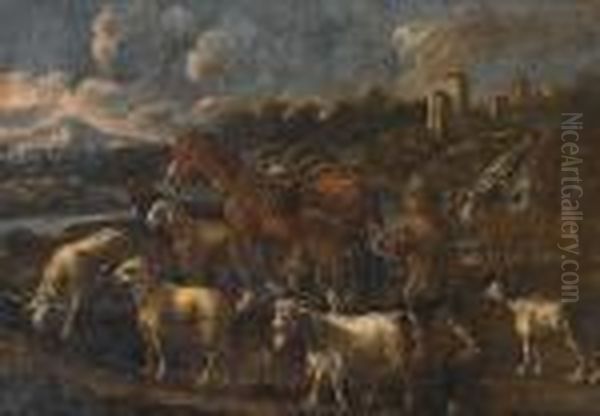
The connection with Giacinto Brandi proved significant not only artistically but also personally. Roos developed a relationship with Brandi's daughter, Maria Isabella Brandi, and the couple eventually married. This union had profound consequences for Roos's life in Rome. It necessitated his conversion to Catholicism, further integrating him into the fabric of Roman society. The marriage also likely strengthened his professional ties and social standing within the local art world, moving him beyond the circle of expatriate Northern artists.
Following his marriage, Roos decided to make Italy his permanent home. He established himself near Tivoli, a town in the hills east of Rome famous for its ancient ruins (like Hadrian's Villa) and dramatic natural scenery, including waterfalls and lush vegetation. This location provided endless inspiration for his landscape backgrounds. He purchased a large house there, which reportedly became so filled with various animals – goats, sheep, oxen, dogs, horses – that he kept for study purposes, that his friends humorously dubbed it "Noah's Ark."
This practice of keeping live models underscores Roos's commitment to direct observation, a trait inherited from the Northern tradition but applied to the Italian environment. It allowed him to capture the specific anatomy, postures, and movements of his animal subjects with remarkable accuracy and vitality. His life in Tivoli cemented his association with the Roman Campagna and its pastoral life, providing the authentic settings that became characteristic of his work. It was during this period that he acquired his most enduring nickname, "Rosa da Tivoli," linking him inextricably to the place that so deeply informed his art.
Artistic Style: Baroque Drama Meets Naturalistic Detail
Philipp Peter Roos's mature style is a compelling synthesis of his German heritage, his Roman training, and his personal observations of Italian nature and light. While firmly rooted in the Baroque era, his work possesses distinct characteristics. He specialized almost exclusively in pastoral landscapes dominated by animals, often featuring shepherds or other rustic figures, set against the backdrop of the Roman Campagna.
A hallmark of his style is the dramatic use of chiaroscuro, the strong contrast between light and shadow. This technique, popularized in Rome by Caravaggio and his followers (the Caravaggisti) earlier in the century, lent a sense of theatricality and volume to his compositions. Animals often emerge from deeply shadowed backgrounds into areas of focused light, highlighting their forms and textures. His palette typically favored rich earth tones – deep browns, ochres, and greens – contributing to a often somber or melancholic mood, though moments of brighter light punctuate the scenes.
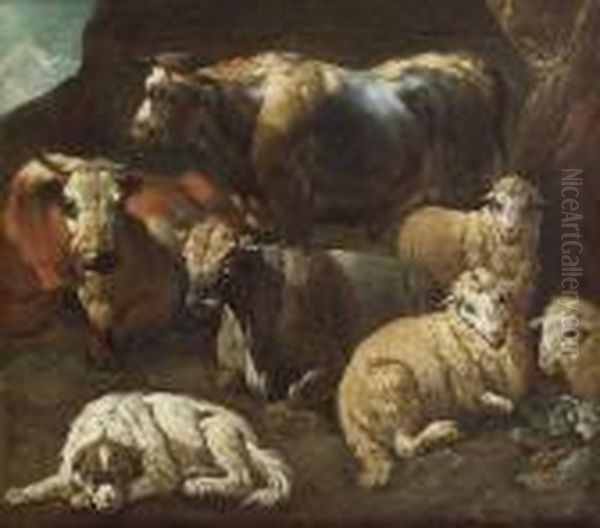
Roos applied paint with a confident, often vigorous brushstroke, particularly adept at rendering the varied textures of animal fur and hides. While capable of fine detail, his work often possesses a certain ruggedness and energy, consistent with his reputation for speed. His compositions are typically dynamic, utilizing diagonal lines created by sloping hillsides, leaning trees, or the arrangement of animal groups. Architectural elements, such as classical ruins, rustic towers, or distant farmhouses, frequently appear, anchoring the scenes in the specific landscape of the Roman environs and adding a touch of picturesque decay or timelessness.
Compared to the highly idealized and serene classical landscapes of contemporaries like Claude Lorrain or Nicolas Poussin, Roos's vision of the Campagna is earthier and more focused on the animal inhabitants. His work shares affinities with the Dutch Italianate painters, such as Nicolaes Berchem or Karel Dujardin, who also depicted pastoral scenes under Italian light, but Roos often imbued his scenes with a stronger sense of Baroque drama and sometimes a more imposing scale. He also differed from the wilder, more romantic landscapes of Salvator Rosa, generally preferring calmer, though sometimes dramatically lit, pastoral subjects.
Subject Matter: The World of Shepherds and Flocks
The core subject matter of Philipp Peter Roos's oeuvre remained remarkably consistent throughout his Italian career: the lives of shepherds and their animals within the landscape of the Roman Campagna. Sheep and goats are ubiquitous in his paintings, often depicted in large groups, resting, grazing, or interacting with each other. Cattle, horses, and dogs also feature prominently, sometimes taking center stage.
His paintings capture moments of daily rural life: a shepherd resting under a tree while his flock grazes nearby, animals gathered around a watering hole, or herds moving through the undulating hills dotted with ruins. The human figures, typically shepherds or peasant women, are usually subordinate to the animals and the landscape, serving more as staffage to complete the pastoral theme rather than as central narrative figures. They are often depicted in simple, rustic clothing, reinforcing the connection to the land.
Roos excelled at capturing the individual character and behavior of animals. His close study, facilitated by the menagerie at his Tivoli home, allowed him to render not just their physical forms accurately but also their characteristic movements and postures – the alert stance of a dog, the placid chewing of a cow, the nimble clambering of goats on rocky outcrops. This focus on animal life, rendered with both naturalism and Baroque energy, distinguishes his work.
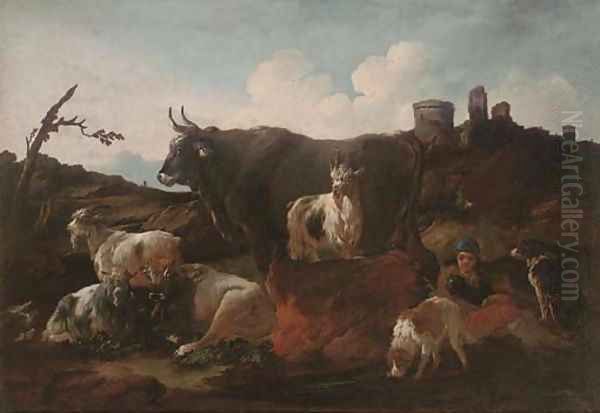
The landscapes themselves, while based on the environs of Rome and Tivoli, are often composed for dramatic effect rather than topographical accuracy. Rolling hills, steep ravines, gnarled trees, and crumbling classical ruins are recurring motifs, creating settings that are both recognizably Italian and imbued with a sense of timeless pastoralism, occasionally touched by a melancholic grandeur.
Representative Works
Several paintings exemplify Philipp Peter Roos's characteristic style and subject matter:
_Pastor y animales en un paisaje (Shepherd and Animals in a Landscape)_: Often featuring a horse prominently alongside sheep and goats, works with this title showcase Roos's ability to integrate various animals into a cohesive pastoral scene. The composition typically employs strong diagonals in the landscape and dramatic lighting, highlighting the textures of the animals' coats against a darker, atmospheric background. The shepherd figure acts as a quiet observer within this animal-dominated world.
_Schäferidylle mit Pferd (Pastoral Idyll with Horse)_: Similar to the above, these works emphasize the idyllic aspect of rural life. A central horse might interact with sheep or goats, while a shepherd rests nearby. The setting is invariably the Italian countryside, perhaps with distant ruins or hills. These paintings demonstrate Roos's skill in rendering animal anatomy and creating a harmonious, albeit often dramatically lit, composition.
_Landscape with Goats and Cattle_: This title represents a common theme where the focus is almost entirely on the animals themselves within their natural habitat. Roos masterfully depicts the varied textures of hides and fleece, capturing the play of light across their forms. The landscape serves as an atmospheric stage, often using dark foregrounds and illuminated middle grounds to create depth and focus attention on the animal groups.
These examples, and numerous others like them found in collections such as the Uffizi Gallery in Florence, the Alte Pinakothek in Munich, and the Gemäldegalerie Alte Meister in Dresden, consistently display his signature blend of detailed animal portrayal, dramatic Baroque lighting, and evocative Italian landscapes.
Productivity, Reputation, and Contemporary Interactions
Philipp Peter Roos was exceptionally prolific, a fact directly linked to his renowned speed of execution – the very quality that earned him the nickname "Mercurius." This rapid output ensured a steady supply of paintings for the art market, where his works were highly sought after by collectors both in Italy and Northern Europe. His specialization in animal painting, a popular genre, combined with his recognizable style, contributed to his commercial success.
However, this very speed sometimes attracted criticism from contemporaries and later art historians. Some felt that his haste occasionally led to a certain formulaic quality or a lack of refinement in execution compared to more meticulous painters. The German artist and biographer Joachim von Sandrart (1606–1688), though primarily active before Roos's peak, represents the kind of connoisseurship that might have scrutinized such rapid production. Despite these critiques, Roos's popularity remained high throughout his career.
His interactions with other artists were primarily centered in Rome. His apprenticeship with Giacinto Brandi and his marriage into Brandi's family placed him within the established Roman art circles. His membership in the Bentvueghels connected him with the Northern European community, which included figures whose styles sometimes intersected with his, like those continuing the tradition of Pieter van Laer ("Il Bamboccio"), known for his small-scale genre scenes of Roman street life (Bamboccianti). While Roos focused on the rural rather than the urban, the shared interest in depicting everyday life in Italy provides a point of connection.
There is less direct documentation of extensive collaboration or close friendships with other major painters after his initial establishment, perhaps due to his somewhat specialized focus and his base in Tivoli, slightly removed from the daily bustle of central Rome. However, his work clearly shows awareness of prevailing artistic trends, particularly the enduring influence of Caravaggio's light and the pastoral traditions refined by artists like Claude Lorrain, even as he forged his own distinct path. He was also a member of the prestigious Roman artists' association, the Congregazione dei Virtuosi al Pantheon, indicating his respected status.
Art Historical Standing and Legacy
In the grand narrative of art history, Philipp Peter Roos, or Rosa da Tivoli, holds a secure place as one of the foremost animal painters (animaliers) of the late Baroque period, particularly among artists of German origin working in Italy. He successfully translated the Northern European tradition of detailed animal depiction, inherited from his father Johann Heinrich Roos, into the context of the Italian Baroque landscape.
His unique contribution lies in this fusion: the meticulous observation of animal life combined with the dramatic lighting, dynamic compositions, and evocative atmosphere characteristic of Roman Baroque painting. While perhaps not reaching the sublime heights of landscape painting achieved by Claude Lorrain or the intellectual depth of Nicolas Poussin, Roos excelled in his chosen niche, creating powerful and engaging images of pastoral life. His work influenced subsequent generations of animal and landscape painters, particularly in Germany and the Netherlands.
His reputation for speed and the sheer volume of his output, while occasionally criticized, also speak to his technical facility and confidence. The enduring presence of his works in major European museums attests to his historical significance and continued appeal. He stands as a prime example of a Northern artist who fully assimilated into the Italian artistic environment, contributing significantly to the diverse tapestry of Baroque art in Rome while retaining a distinct personal and national inflection. His life story, including the "Noah's Ark" anecdote and his evocative nicknames, adds a layer of memorable personality to his artistic achievements.
Conclusion
Philipp Peter Roos, the "Rosa da Tivoli," was more than just a painter of sheep and goats. He was an artist who bridged cultures, skillfully blending his Northern training with the powerful influences of the Italian Baroque. From his beginnings in an artistic family in Frankfurt to his celebrated career in Rome and Tivoli, he dedicated himself to capturing the essence of pastoral life in the Italian Campagna. His dramatic use of light, detailed rendering of animals, and evocative landscapes created a signature style that found widespread acclaim. Though his prolific output sometimes invited criticism, his technical skill and the enduring appeal of his subjects cemented his reputation. As a key figure in Baroque animal painting and a fascinating example of artistic migration and synthesis, Philipp Peter Roos remains an important and engaging artist worthy of continued study and appreciation.